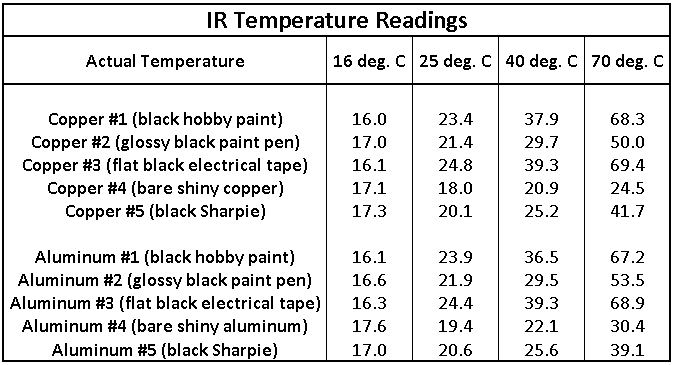Infrared Temperature
Measurements
Copyright © 2012 Larry Benko, W0QE

A few years ago I bought a close focus infrared thermometer pen with dual laser pointers which can measure the temperature of a 0.1" diameter dot at a 0.7" distance from the pen. I have often used this device to measure SMD component temperatures. The results have been good and the convenience of non-contact measurements should not be overlooked. The particular unit I purchased has adjustable emissivity but I generally leave it at the default setting of 0.95 for most SMD measurements.
Click on picture for larger image
Recently I was getting ready to make some heat sink measurements on an amplifier project I was working on and decided to do some preemptive tests to see how easy it might be to measure the temperature of either copper or aluminum heatsinks. Shiny reflective surfaces present problems for IR thermometers unless the emissivity is adjusted to match the material. However how much should the emissivity be adjusted? Is is different for shiny metals compared to the same metal after it becomes oxidized and dull?
The test setup is shown in the picture below with both copper and aluminum pieces which are shiny from just having been machined smooth. Absolute temperature calibration was done by comparing some small precision thermistors to a Kodak film process thermometer in a water bath and to several Fluke temperature probes. Everything agreed within +/-0.5 degrees C over the range of 15 to 70 degrees C. Then I embedded the precision thermistors into the copper and aluminum test pieces with some heatsink compound and placed them on top of a silicone rubber heater. After powering the heater from a variable power supply and waiting for the temperature to stabilize, both pieces of metal were within 0.25 degrees C of each other.
Initial infrared measurements on the bare metal were good at 16 degrees C but when I increased the temperature the IR measurements became terrible. I expected problems and it is common practice to coat/paint surfaces to get better IR measurements if you can't or don't want to change emissivity.
The test setup is shown in the picture below with both copper and aluminum pieces which are shiny from just having been machined smooth. Absolute temperature calibration was done by comparing some small precision thermistors to a Kodak film process thermometer in a water bath and to several Fluke temperature probes. Everything agreed within +/-0.5 degrees C over the range of 15 to 70 degrees C. Then I embedded the precision thermistors into the copper and aluminum test pieces with some heatsink compound and placed them on top of a silicone rubber heater. After powering the heater from a variable power supply and waiting for the temperature to stabilize, both pieces of metal were within 0.25 degrees C of each other.
Initial infrared measurements on the bare metal were good at 16 degrees C but when I increased the temperature the IR measurements became terrible. I expected problems and it is common practice to coat/paint surfaces to get better IR measurements if you can't or don't want to change emissivity.
I used some commonly available coatings that were convenient to see how these coatings might affect the IR temperature readings. Dot #1 was some moderately glossy black hobby paint in a little bottle with a brush in the lid. Dot #2 was a glossy black paint pen that can be found at office supply stores. Dot #3 was flat black electrical tape. Dot #4 was just the bare metal and dot #5 was a black Sharpie permanent marker. The results are shown in the table below with the winner being the flat black electrical tape. The hobby paint was fairly good and would probably have been better if it was flat black rather than semi-gloss. For higher temperatures flat black paint might be a better choice than the tape but the Scotch electrical tape did not degrade at 70 degrees C. I was surprised at how close all the readings were at 16 degrees C.
Page content last updated Mar. 9, 2012 (orig. content Feb. 29, 2012)
Update Mar. 9, 2012:
I received a few comments about including some high temperature flat black stove or barbeque paint or just some regular flat black paint in the experiments. I purchased a can of Rustoleum High Temperature (flat black spray paint) and a can of Rustoleum Flat Black spray paint (not high temperature).
I sprayed some paint from each can onto pieces of cardboard scrap and then used a cotton Q-Tip as a paint brush to make paint dots about 1/2" in diameter on the piece of copper I used above. Then I did the tests again at 70 deg. C.
With the heatsink temperature at 70 deg. C based on the precision thermistor the infrared pen indicated 69.3 deg. C when measuring the flat black electrical tape (agreeing well with the original test). Both the high temperature and the regular flat black paint dots read 69.7 deg. C which was even closer to the correct temperature. Again for these tests the infrared pen had the emissivity set to the default value of 0.95.
Conclusion
The 2 samples of flat black paint produced slightly more accurate readings that the black electrical tape but all 3 were accurate enough for most measurements. I would use whichever was most convenient to use. I can't vouch for the absolute accuracy of my infrared pen thermometer but the consistentcy of the various measurements was quite good and hopefully the experiment may be beneficial to others.

